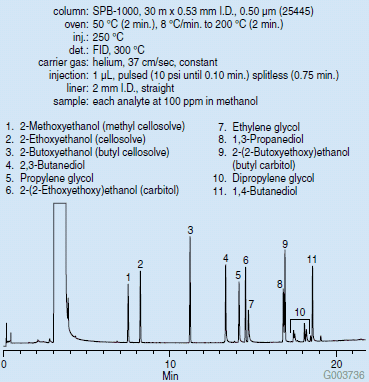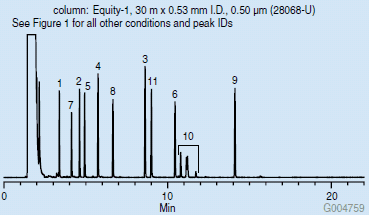GC Analysis of Glycols and Diols
Introduction
Glycol and diol compounds are used to solubilize active ingredients for use in many consumer products, including cosmetics, ballpoint pen inks, wood stains, and lacquers. They are also used as co-monomers in polymerization reactions to form polyesters and polyurethanes.1 For safety and quality purposes, proper identification and purity checks of these raw materials are necessary.
Column Phase Selection
The chemical properties of these compounds, particularly the multiple active hydroxyl (-OH) functional groups, must be considered when selecting an appropriate phase for GC analysis. A polar (polyethylene glycol/Carbowax® 20M) phase is the traditional choice for the separation of polar compounds, however, glycol and diol peaks will exhibit tailing on unmodified phases of this type due to the strong interaction between -OH functional groups. A non-polar column such as a poly(dimethylsiloxane) can be used to minimize these interactions, however it may not provide the retention and/or selectivity necessary for the separation.
Polar Column Choice: The SPB-1000
For a polar column, the SPB-1000 is a good choice. This column is made with a modified polyethylene glycol phase that incorporates acidic functional groups. These groups lend an acidic character to this column, acting as a tailing inhibitor for active, acidic analytes. Figure 1 illustrates the separation of a variety of glycols and diols on the SPB-1000.

Figure 1.Glycols and Diols on the SPB-1000 (25445)
Non-Polar Column Choice: The Equity-1
Poly(dimethylsiloxane) is a non-polar GC phase, and will not interact as strongly with polar compounds as a polar polyethylene glycol phase. As a result, retention will not be as strong, and tailing may be decreased. Figure 2 illustrates the separation on an Equity-1 column of the same mix shown in Figure 1. Notice the significant reduction in retention, and change in elution order as compared to the SPB-1000.

Figure 2.Glycols and Diols on the Equity-1 (28068-U)
Conclusion
Phase selection is the most important factor when selecting a GC column.2 There may be several phases of different chemistries that are able to perform an application, and the specific needs of the application should be considered when making a choice. For example, if it is necessary to analyze 2-ethoxyethanol for the presence of other glycols, the SPB-1000 may be a better choice than the Equity-1, as it will provide greater retention and better separation. Check available application information to help determine the best column choice. Also, consider consulting with the column manufacturer about your specific application. Supelco’s Technical Service chemists can provide you with expert technical advice to aid in your column selection and method development.
References
Para seguir leyendo, inicie sesión o cree una cuenta.
¿No tiene una cuenta?